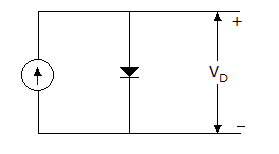Test: Electronic Devices & Circuits - 4 - Electrical Engineering (EE) MCQ
25 Questions MCQ Test - Test: Electronic Devices & Circuits - 4
An increase in junction temperature of a semiconductor diode
An air gap provided in the iron core of an inductor prevents
| 1 Crore+ students have signed up on EduRev. Have you? Download the App |
Generally, the gain of a transistor amplifier falls at high frequency due to the
Which of these has a layer of intrinsic semiconductor?
Assertion (A): When Diode used as rectifier the reverse breakdown voltage should not be exceeded.
Reason (R): A high inverse voltage can destroy a p-n junction.
A Si sample is doped with a fixed number of group N impurities. The electron density n is measured from 4 K to 1200 k for the sample. Which one of the following is correct?
Assertion (A): In design of circuit using BJT, a derating factor is used.
Reason (R): As the ambient temperature increases, heat dissipation becomes slower.
If the drift velocity of holes under a field gradient of 100 V/m is 5m/sec. Their mobility is
In a P type silicon sample, the hole concentration is 2.25 x 1015 / cm3. If the intrinsic carrier concentration is 1.5 x 1010/ cm3 the electron concentration is
The behaviour of a JFET is similar to that of
What is the effect of cut in voltage on the wave form of output as compared to input in a semiconductor diode?
As temperature increases the number of free electrons and holes in an intrinsic semiconductor
Assertion (A): A JFET behaves as a resistor when VGS < VP.
Reason (R): When VGS < VP, the drain current in a JFET is almost constant.
In a reverse biased P-N junction, the current through the junction increases abruptly at
Dielectric strength of polythene is around
In a bipolar junction transistor adc = 0.98, ICO= 2 μA and 1B = 15 μA. The collector current IC is
The voltage across the secondary of the transformer in a half wave rectifier with a shunt capacitor filter is 50 volts. The maximum voltage that will occur on the reverse biased diode will be
Assertion (A): The forward resistance of a p-n diode is not constant.
Reason (R): The v-i characteristics of p-n diode is non-linear.
In a varactor diode the increase in width of depletion layer results in
In given figure a silicon diode is carrying a constant current of 1 mA. When the temperature of the diode is 20ºC, VD is found to be 700 mV. If the temperature rises to 40ºC, VD becomes approximately equal to

The work function of a photo surface whose threshold wave length is 1200 A, will be


 μ =
μ = .
. .
.
 , then
, then
 = eVD/ηVT
= eVD/ηVT


 VD a T
VD a T



 .
.














